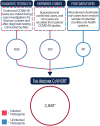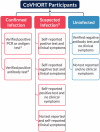Design of the Arizona CoVHORT: A Population-Based COVID-19 Cohort
- PMID: 33643990
- PMCID: PMC7902773
- DOI: 10.3389/fpubh.2021.620060
Design of the Arizona CoVHORT: A Population-Based COVID-19 Cohort
Abstract
This study is a prospective, population-based cohort of individuals with a history of SARS-CoV-2 infection and those without past infection through multiple recruitment sources. The main study goal is to track health status over time, within the diverse populations of Arizona and to identify the long-term consequences of COVID-19 on health and well-being. A total of 2,881 study participants (16.2% with a confirmed SARS-CoV-2 infection) have been enrolled as of December 22, 2020, with a target enrollment of 10,000 participants and a planned follow-up of at least 2 years. This manuscript describes a scalable study design that utilizes a wide range of recruitment sources, leveraging electronic data collection to capture and link longitudinal participant data on the current and emerging issues associated with the COVID-19 pandemic. The cohort is built within a collaborative infrastructure that includes new and established partnerships with multiple stakeholders, including the state's public universities, local health departments, tribes, and tribal organizations. Challenges remain for ensuring recruitment of diverse participants and participant retention, although the electronic data management system and timing of participant contact can help to mitigate these problems.
Keywords: COVID-19; SARS-CoV-2; cohort study [or longitudinal study]; epidemiology; long-term follow up.
Copyright © 2021 Catalfamo, Heslin, Shilen, Khan, Hunsaker, Austhof, Barraza, Cordova-Marks, Farland, Garcia-Filion, Hoskinson, Jehn, Kohler, Lutrick, Harris, Chen, Klimentidis, Bell, Ernst, Jacobs and Pogreba-Brown.
Conflict of interest statement
The authors declare that the research was conducted in the absence of any commercial or financial relationships that could be construed as a potential conflict of interest.
Figures



References
Publication types
MeSH terms
Grants and funding
LinkOut - more resources
Full Text Sources
Other Literature Sources
Medical
Miscellaneous

